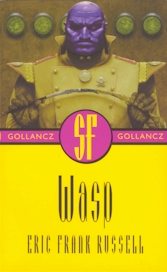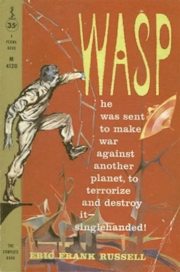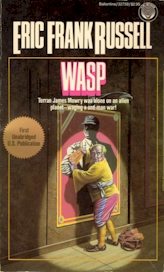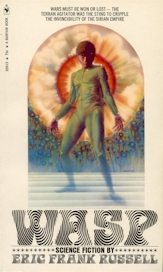
Gollancz SF trade paperback
cover art by Jim Burns
175 pages
1959 Permabook first paperback edition
cover art by Art Sussman
170 pages - 35¢ cover price!

Denver Science Fiction & Fantasy Book Club |
 |
Wasp (1957) Gollancz SF trade paperback cover art by Jim Burns 175 pages 1959 Permabook first paperback edition cover art by Art Sussman 170 pages - 35¢ cover price! |
 |
 |
More book covers: Wasp first unabridged U.S. publication, 1986 contains introduction by Jack L. Chalker Del Rey books paperback, 196 pages cover art by Barclay Shaw (left) 1971 Bantam books paperback 154 pages (right) |
 |
| Dan | 7 | Amy | 7.5 |
 |
10 Wow! Don't miss it 8-9 Highly recommended 7 Recommended 5-6 Mild recommendation 3-4 Take your chances 1-2 Below average; skip it 0 Get out the flamethrower! U Unfinishable or unreadable - Skipped or no rating given |
| Cheri | 9 | Barb | - | ||
| Aaron | 6 | Cynthia | 7 | ||
| Jackie | - | Ron | 7 | ||
| Christine | 7 | Mitch | 9 | ||
| Amelia | 7 |
|
Aaron's Commentary
Eric Frank Russell - Wasp
This is an entertaining spy yarn, placed in a science fictional setting. It’s the familiar story of a fugitive on the run from justice, but with a nice twist – even as the authorities close in on James Mowry, he is always actually the aggressor. Russell’s writing is understated, but with occasional clever touches, such as when a hotel clerk wishes his customer a long life, "obviously not caring if the customer expired on the spot." I particularly liked the last few pages, when Russell slips in a little bit on the military mentality that calls to mind Catch-22, which Wasp predates. I was disappointed at the lack of imagination in the science fiction elements of the story. We are told that humans enjoy technological superiority over Sirians, yet Mowry employs remarkably low-tech, albeit often ingenious, methods for his one-man campaign of espionage and sabotage. More importantly, the Sirians and their planet are not alien enough. In an early scene, Mowry decides to follow a Sirian official home. So he jumps in a taxi, has the driver follow the official’s car, pays the driver and tips him 25%, waits in the lobby of the official’s apartment for him to emerge from his parking garage, observes him get in the elevator, watches the numbers above the elevator doors to see what floor the official lives on, gets the guy’s name from the apartment’s switchboard operator, telephones and gets no answer, figures that the guy most have left again because he didn’t have time to run a bath, goes up and knocks on the door, picks the lock, goes in and begins ransacking the guy’s closet and file drawers. By the end of this scene, I was wondering if there are any differences between Sirian culture and our own. This shortcoming is surprising coming from Russell, whose short stories of space exploration such as "Symbiotica" always featured very imaginative space aliens. It is a bit creepy to read Wasp right now. This is a book written in 1957, in which our hero infiltrates a foreign land using arguably terrorist tactics to undermine the enemy. I had no trouble accepting Mowry as the good guy, and yet a story about a Muslim in our present-day society using Mowry’s tactics would draw an entirely different reaction. Perhaps Russell intended the book to have this unsettling edge – a 1957 reader might have been just as disturbed comparing Mowry to the communist infiltrators our society then feared. Science fictional visions of the future often serve only to remind us how little things have changed. What do you think? Your comments are welcome. Please send them to vanaaron@excite.com |